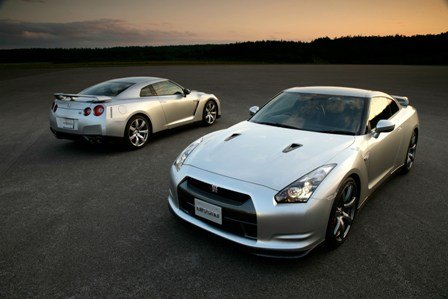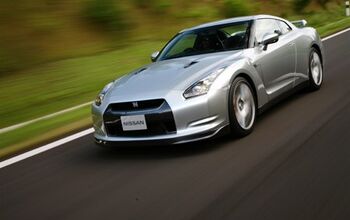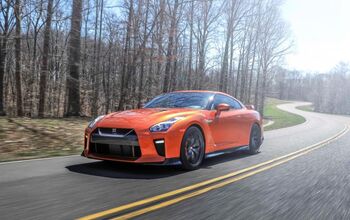Nissan GT-R: What Price New Hotness?
In Michelangelo Antonioni's film "Blow Up," Thomas (David Hemming) watches a rock guitarist smash his ax and toss the remnants into the audience. Caught up in the spirit of the moment, Thomas joins the scrum scrambling for a piece of the dead guitar. He grabs the lion's share and runs away. Dozens of fans give chase, attempting to wrest the prize from his grasp. Finally, Thomas is clear of the crowd. Alone with his treasure, he contemplates his booty– and then casually tosses it into a nearby trash can. Nissan GTR anyone?
Sacrilege! The new Nissan GT-R blasts from zero to 60mph in 3.5 seconds, navigates the Nürburgring as fast as the Porsche 911 Turbo and (allegedly) does so with more confidence than Stuttgart's finest. All this with a Manufacturer's Suggested Retail Price (MSRP) starting just under $70k. Clearly, it's the performance automotive bargain of the decade.
On the day the initial U.S. dealer allocations of GT-Rs were announced, the mathematics made the problem clear. Nissan deemed exactly 691 dealers "qualified" (i.e. large and financially productive enough) to sell the GT-R. During the model's inaugural year, Nissan will build 2500 GT-Rs worldwide, only 1400 vehicles of which will make it stateside.
It doesn't take long to divide 1400 by 691 and conclude that the anointed U.S. Nissan dealers will receive two GT-Rs (on average). Since these dealers were obliged to make an investment in the equipment needed to service the GT-R's unique run flat tires, it makes sense that they'd want to recoup that investment ASAP, over the two model transactions they'll experience in 2008. And, lest we forget, they're car dealers.
Bottom line: a "buyer's premium."
So when I contacted my local dealer to place an order for my very own Nissan GT-R, I wasn't surprised to encounter a lot of squirming and shadow puppeteering. This, of course, gave me a reverse Groucho Marx; I wanted to join a club that didn't want me as a member. BUT–
I am allergic to paying more than MSRP for anything (I have a doctor's note to prove it). The idea of forking over a significant premium for a GT-R in its first year of release makes me feel both elated and stupid.
To delete "stupid" from this equation, I began an on-line investigation, hoping to tap the experiences of other enthusiasts desperately seeking a Nissan GT-R. Most of the stories I encountered indicated that dealers were adding a $10k to $25k additional onto the car's MSRP.
About a half dozen commentators listed dealers committed to selling their GT-Rs at MSRP. This information did me little good, as one sale accounted for half of their allocation. By the time I'd identified the virtuous dealer their other GT-R was also sold. Living in California didn't help; the Golden State's love for fast cars seems to blur the lines of whatever rational decision-making may remain within state borders.
Of course, the upshot of this hot model fever is a four-wheeled Ponzi scheme. Aside from the Ferrari Enzo, you can count on one hand the number of cars that garnered a premium from the onset, and maintained that value (and you'd still have enough fingers left to make gang signs). Anyone remember the $100k dealers placed on top of the dreadful BMW Z8? The SL55 AMG for $50k on top? And yes, people paid above the odds for a Pontiac Solstice.
Eventually, as the hot model cools, someone gets burned. IF you're going to pay a premium for a hot car, the "trick" is to do so straight out of the chute, then sell the car before availability catches-up with demand. Given that the Nissan GT-R ain't no Ferrari, and Nissan dealers love money, I reckon Nissan will up production after the 2008 model year, big style. At that point, the premium will disappear, for both buyer and seller.
You want to talk about killer depreciation? Then you need to contemplate the concept of "front loading" an asset destined to shed value. A 2005 SL55 AMG with less than 20k on the clock can now be yours for $86k as a certified pre-owned car from an MB dealer- and a lot less as a private purchase. With Solsti piling-up on dealer lots, there isn't a single soul in the U.S. who'll pay you above the odds for a new one. Not one.
So I'm hot on this quest to find someone who will accept my order for a Nissan GTR at MSRP and I've never even seen one in person– let alone felt the driving experience. Two questions. How long will the hype last? With all this demand and little supply, how long will there be someone willing to pluck this discard from my trash heap and pay ME more than MSRP for the privilege? Second, would I even like it?
More by Jay Shoemaker
Latest Car Reviews
Read moreLatest Product Reviews
Read moreRecent Comments
- ToolGuy First picture: I realize that opinions vary on the height of modern trucks, but that entry door on the building is 80 inches tall and hits just below the headlights. Does anyone really believe this is reasonable?Second picture: I do not believe that is a good parking spot to be able to access the bed storage. More specifically, how do you plan to unload topsoil with the truck parked like that? Maybe you kids are taller than me.
- ToolGuy The other day I attempted to check the engine oil in one of my old embarrassing vehicles and I guess the red shop towel I used wasn't genuine Snap-on (lots of counterfeits floating around) plus my driveway isn't completely level and long story short, the engine seized 3 minutes later.No more used cars for me, and nothing but dealer service from here on in (the journalists were right).
- Doughboy Wow, Merc knocks it out of the park with their naming convention… again. /s
- Doughboy I’ve seen car bras before, but never car beards. ZZ Top would be proud.
- Bkojote Allright, actual person who knows trucks here, the article gets it a bit wrong.First off, the Maverick is not at all comparable to a Tacoma just because they're both Hybrids. Or lemme be blunt, the butch-est non-hybrid Maverick Tremor is suitable for 2/10 difficulty trails, a Trailhunter is for about 5/10 or maybe 6/10, just about the upper end of any stock vehicle you're buying from the factory. Aside from a Sasquatch Bronco or Rubicon Jeep Wrangler you're looking at something you're towing back if you want more capability (or perhaps something you /wish/ you were towing back.)Now, where the real world difference should play out is on the trail, where a lot of low speed crawling usually saps efficiency, especially when loaded to the gills. Real world MPG from a 4Runner is about 12-13mpg, So if this loaded-with-overlander-catalog Trailhunter is still pulling in the 20's - or even 18-19, that's a massive improvement.


































Comments
Join the conversation
The guitarist was Jimmy Page and also on stage was Jeff Beck. It was the last incarnation of the Yardbirds before they morphed into Led Zeppelin. Oh Yes. About the car? I dunno
[...] Source: http://www.thetruthaboutcars.com/2008/02/unobtainable-at-msrp/ [...]